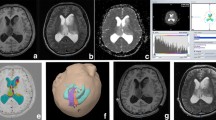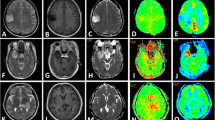Abstract
Introduction
Accurate grading of cerebral glioma using conventional structural imaging techniques remains challenging due to the relatively poor sensitivity and specificity of these methods. The purpose of this study was to evaluate the relative sensitivity and specificity of structural magnetic resonance imaging and MR measurements of perfusion, diffusion, and whole-brain spectroscopic parameters for glioma grading.
Methods
Fifty-six patients with radiologically suspected untreated glioma were studied with T1- and T2-weighted MR imaging, dynamic contrast-enhanced MR imaging, diffusion tensor imaging, and volumetric whole-brain MR spectroscopic imaging. Receiver-operating characteristic analysis was performed using the relative cerebral blood volume (rCBV), apparent diffusion coefficient, fractional anisotropy, and multiple spectroscopic parameters to determine optimum thresholds for tumor grading and to obtain the sensitivity, specificity, and positive and negative predictive values for identifying high-grade gliomas. Logistic regression was performed to analyze all the parameters together.
Results
The rCBV individually classified glioma as low and high grade with a sensitivity and specificity of 100 and 88 %, respectively, based on a threshold value of 3.34. On combining all parameters under consideration, the classification was achieved with 2 % error and sensitivity and specificity of 100 and 96 %, respectively.
Conclusion
Individually, CBV measurement provides the greatest diagnostic performance for predicting glioma grade; however, the most accurate classification can be achieved by combining all of the imaging parameters.



Similar content being viewed by others
References
Law M, Yang S, Wang H et al (2003) Glioma grading: sensitivity, specificity, and predictive values of perfusion MR imaging and proton MR spectroscopic imaging compared with conventional MR imaging. AJNR Am J Neuroradiol 24:1989–1998
Chiang IC, Kuo YT, Lu CY et al (2004) Distinction between high-grade gliomas and solitary metastases using peritumoral 3-T magnetic resonance spectroscopy, diffusion, and perfusion imagings. Neuroradiology 46:619–627
Server A, Orheim TE, Graff BA et al (2011) Diagnostic examination performance by using microvascular leakage, cerebral blood volume, and blood flow derived from 3-T dynamic susceptibility-weighted contrast-enhanced perfusion MR imaging in the differentiation of glioblastoma multiforme and brain metastasis. Neuroradiology 53:319–330
Zonari P, Baraldi P, Crisi G (2007) Multimodal MRI in the characterization of glial neoplasms: the combined role of single-voxel MR spectroscopy, diffusion imaging and echo-planar perfusion imaging. Neuroradiology 49:795–803
Arvinda HR, Kesavadas C, Sarma PS et al (2009) Glioma grading: sensitivity, specificity, positive and negative predictive values of diffusion and perfusion imaging. J Neurooncol 94:87–96
Hlaihel C, Guilloton L, Guyotat J et al (2010) Predictive value of multimodality MRI using conventional, perfusion, and spectroscopy MR in anaplastic transformation of low-grade oligodendrogliomas. J Neurooncol 97:73–80
Awasthi R, Rathore RKS, Soni P et al (2012) Discriminant analysis to classify glioma grading using dynamic contrast-enhanced MRI and immunohistochemical markers. Neuroradiology 54:205–213
Moon WJ, Choi JW, Roh HG et al (2012) Imaging parameters of high grade gliomas in relation to the MGMT promoter methylation status: the CT, diffusion tensor imaging, and perfusion MR imaging. Neuroradiology 54:555–563
Catalaa I, Henry R, Dillon WP et al (2006) Perfusion, diffusion and spectroscopy values in newly diagnosed cerebral gliomas. NMR Biomed 19:463–475
Di Costanzo A, Scarabino T, Trojsi F et al (2006) Multiparametric 3T MR approach to the assessment of cerebral gliomas: tumor extent and malignancy. Neuroradiology 48:622–631
Kim JH, Chang KH, Na DG et al (2006) 3T 1H-MR spectroscopy in grading of cerebral gliomas: comparison of short and intermediate echo time sequences. AJNR Am J Neuroradiol 27:1412–1418
Jolapara M, Patro SN, Kesavadas C et al (2011) Can diffusion tensor metrics help in preoperative grading of diffusely infiltrating astrocytomas? A retrospective study of 36 cases. Neuroradiology 53:63–68
Jakab A, Molnár P, Emri M et al (2011) Glioma grade assessment by using histogram analysis of diffusion tensor imaging-derived maps. Neuroradiology 53:483–491
Liu X, Tian W, Kolar B et al (2011) MR diffusion tensor and perfusion-weighted imaging in preoperative grading of supratentorial nonenhancing gliomas. Neuro Oncol 13:447–455
Law M, Yang S, Babb JS et al (2004) Comparison of cerebral blood volume and vascular permeability from dynamic susceptibility contrast-enhanced perfusion MR imaging with glioma grade. AJNR Am J Neuroradiol 25:746–755
Jia Z, Geng D, Xie T et al (2012) Quantitative analysis of neovascular permeability in glioma by dynamic contrast-enhanced MR imaging. J Clin Neurosci 19:820–823
Maudsley AA, Darkazanli A, Alger JR et al (2006) Comprehensive processing, display and analysis for in vivo MR spectroscopic imaging. NMR Biomed 19:492–503
Awasthi R, Verma SK, Haris M et al (2010) Comparative evaluation of dynamic contrast-enhanced perfusion with diffusion tensor imaging metrics in assessment of corticospinal tract infiltration in malignant glioma. J Comput Assist Tomogr 34:82–88
Singh A, Haris M, Rathore D et al (2007) Quantification of physiological and hemodynamic indices using T1 dynamic contrast-enhanced MRI in intracranial mass lesions. J Magn Reson Imaging 26:871–880
Server A, Graff BA, Orheim TE et al (2011) Measurements of diagnostic examination performance and correlation analysis using microvascular leakage, cerebral blood volume, and blood flow derived from 3T dynamic susceptibility-weighted contrast-enhanced perfusion MR imaging in glial tumor grading. Neuroradiology 53:435–447
Haegler K, Wiesmann M, Böhm C et al (2012) New similarity search based glioma grading. Neuroradiology 54:829–837
Pope WB, Sayre J, Perlina A et al (2005) MR imaging correlates of survival in patients with high-grade gliomas. AJNR Am J Neuroradiol 26:2466–2474
Chaichana KL, McGirt MJ, Niranjan A et al (2009) Prognostic significance of contrast-enhancing low-grade gliomas in adults and a review of the literature. Neurol Res 31:931–939
Lote K, Egeland T, Hager B et al (1998) Prognostic significance of CT contrast enhancement within histological subgroups of intracranial glioma. J Neurooncol 40:161–170
Tynninen O, Aronen HJ, Ruhala M et al (1999) MRI enhancement and microvascular density in gliomas. Correlation with tumor cell proliferation. Invest Radiol 34:427–434
Shin JH, Lee HK, Kwun BD et al (2002) Using relative cerebral blood flow and volume to evaluate the histopathologic grade of cerebral gliomas: preliminary results. AJR Am J Roentgenol 179:783–789
Narang J, Jain R, Scarpace L et al (2011) Tumor vascular leakiness and blood volume estimates in oligodendrogliomas using perfusion CT: an analysis of perfusion parameters helping further characterize genetic subtypes as well as differentiate from astroglial tumors. J Neurooncol 102:287–293
Maudsley AA, Domenig C, Govind V et al (2009) Mapping of brain metabolite distributions by volumetric proton MR spectroscopic imaging (MRSI). Magn Reson Med 61:548–559
McLean MA, Sun A, Bradstreet TE et al (2012) Repeatability of edited lactate and other metabolites in astrocytoma at 3T. J Magn Reson Imaging 36:468–475
Hattingen E, Delic O, Franz K et al (2010) (1)H MRSI and progression-free survival in patients with WHO grades II and III gliomas. Neurol Res 32:593–602
Acknowledgments
This work was supported in part by Indo-US Science and Technology Forum award no. 20-2009. BR received financial assistance from the University Grant Commission, New Delhi, India. RA received financial assistance from the Indian Council of Medical Research, New Delhi, India. Sequence and software development was carried out under NIH grant R01EB000822.
Conflict of interest
We declare that we have no conflict of interest.
Author information
Authors and Affiliations
Corresponding author
Rights and permissions
About this article
Cite this article
Roy, B., Gupta, R.K., Maudsley, A.A. et al. Utility of multiparametric 3-T MRI for glioma characterization. Neuroradiology 55, 603–613 (2013). https://doi.org/10.1007/s00234-013-1145-x
Received:
Accepted:
Published:
Issue Date:
DOI: https://doi.org/10.1007/s00234-013-1145-x




